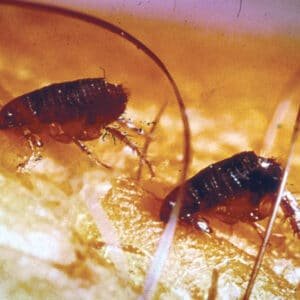
FLEAS
FUN FACT
A single flea can bite up to 400 times a day and consume up to 15 times its body weight in blood, making them highly effective parasites.
Schedule Your Flea RemovalCall (512) 764-5804Identification
Fleas are small, wingless insects that are notorious for their ability to jump long distances and their parasitic behavior, feeding on the blood of mammals and birds. In Texas, common species include the cat flea, which can infest a variety of pets and wildlife. Fleas are typically found in warm, humid environments, making Texas an ideal habitat.
Signs of Infestation
- Pet Scratching: Excessive scratching, biting, or grooming by pets can indicate flea bites.
- Visible Fleas: Small, dark, fast-moving insects seen on pets or in pet bedding.
- Flea Dirt: Tiny black specks, which are flea feces, found on pet skin or bedding.
- Bite Marks: Red, itchy bites on human skin, often around the ankles and legs.
- Pale Gums: In severe infestations, pets might show signs of anemia, such as pale gums.
Breeding Season
Fleas can breed year-round in Texas due to the warm climate. Female fleas lay eggs on their host, which then fall off into the environment. These eggs hatch into larvae, which develop into pupae and eventually emerge as adult fleas. The entire life cycle can be completed in as little as two weeks under optimal conditions.
Ecosystem Role
While fleas are primarily seen as pests, they play minor roles in the ecosystem:
- Food Source: Fleas serve as a food source for some birds and small mammals.
- Parasitism: They help control animal populations by affecting the health of their hosts.
Prevention Strategies
- Regular Pet Care: Regularly bathe and groom pets using flea control shampoos and treatments.
- Clean Bedding: Frequently wash pet bedding in hot water and vacuum carpets and furniture.
- Yard Maintenance: Keep lawns, shrubs, and trees well-trimmed to reduce flea habitats.
- Flea Control Products: Use flea collars, topical treatments, and oral medications as recommended by veterinarians.
- Pest Control: Consider professional pest control treatments for severe infestations.
Prickly Pear’s Approach
- Inspection: Conduct a thorough inspection to identify flea infestation levels and sources.
- Pet Treatment: Advise on effective pet flea treatments and prevention strategies.
- Indoor Treatment: Use safe and effective insecticides to treat carpets, furniture, and pet bedding.
- Outdoor Treatment: Apply yard treatments to reduce flea populations in the environment.
- Ongoing Monitoring: Regularly monitor and adjust strategies to ensure long-term flea control.
Conclusion
Fleas can quickly become a significant problem for both pets and humans if not addressed promptly. Prickly Pear offers professional services to manage flea infestations and protect your home. If you suspect a flea problem, contact us for expert assistance in maintaining a flea-free environment.
